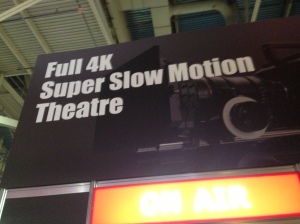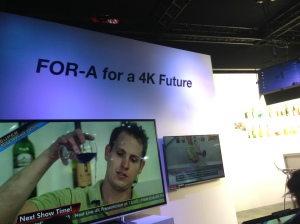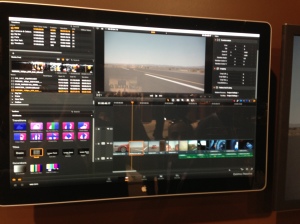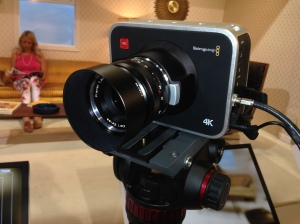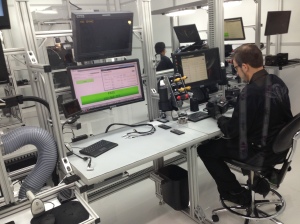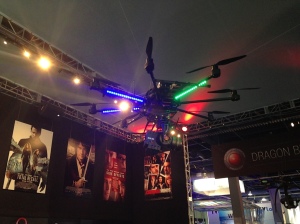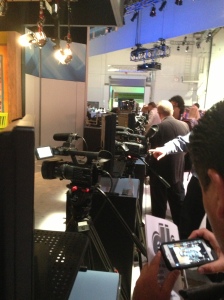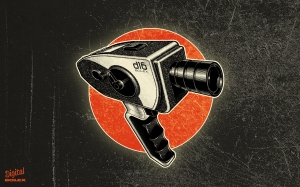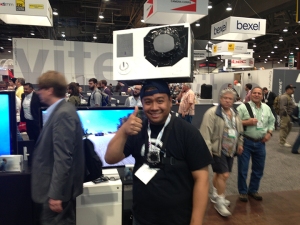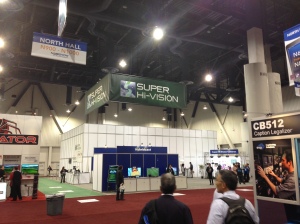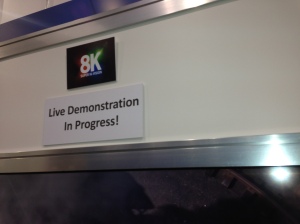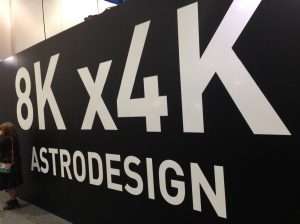Emerging Patterns
Every year, if I’m able to do so, I make the 4-hour trek by car from Los Angeles to Las Vegas to attend the National Association of Broadcasters Convention (NAB). For the uninitiated, it’s a trade show where all the manufacturers of every piece of gear involving broadcast, filmmaking, production, postproduction, you-name-it fill a massive convention center in Las Vegas for a week of every year. It’s like ComiCon for filmmakers – a chance to see all the new gear, computer programs, lenses, etc. to expect in the following months, a glimpse perhaps into our production workflow-to-come. My first NAB was exactly ten years ago, and even though I can’t make it ever year, it’s a great way to check in on all the trends in filmmaking. A way to see what will be possible in the near future.
Three years ago, I blogged about the the ubiquity of 3D technology which manufacturers presumed would be the next big thing as filmmakers prayed it would not (spoiler alert – a little of both, but nobody’s out of business because they failed to spend tens or hundreds of thousands of dollars on 3D technology for their business making industrial safety videos for the trucking industry). That year also marked the DSLR (Digital Single Lens Reflex) camera coming into its own. 3D was a thing we all had to know about, but small form-factor, affordable, high-quality cameras were an actual game changer.
Some questions about NAB can never be answered, like “why is all the good food in the hall with all the radio crap when we have that sloppy Indian place in the central hall?” or “why do I end up with 5lbs of swag (I weighed it) that I will only throw away in six months?” And also, “what do the weasel-words ‘innovative network solutions for enterprise technology customers’ mean?” The world may never know. But for NAB 2013, the year was one of… Incremental progress.
Special K
Yes, 4K. We’ve moved up one number and seven letters in the alphabet from 3D, and now we’re all about pixels. 4,000 of them. I don’t know if it’s really true, but the common wisdom about 4K is that it’s approximately the native resolution of 35mm film (that plasticky/punch-holey stuff we used to make movies on). Does it matter that nobody has a monitor – otherwise known as a television – that will display this amazing 4K content? No. 4K is the thing you want. Now. Hadn’t you heard?
Editing
As I blogged about last year, much of the nonlinear editing (NLE) world has furiously pushed to fill the void left by the departure of the venerable Final Cut Pro as it transformed itself into the aforementioned nonprofessional mistake known as FCPX. The challengers to the FCP throne have all been people who were already in the post world (unlike FCP when it first emerged), notably Avid (already the undisputed industry leader for the longest time), Adobe Premiere (my tool of choice for editing today, but something the pro editing world hasn’t fully embraced), and last year Autodesk Smoke (my opinion – too expensive, too complicated, and the NLE is too underdeveloped). So this year, add DaVinci Resolve 10 from Blackmagic Design – you’ll be hearing me talk about this company a bit more – added the beginnings of a NLE into the Resolve interface. The people at the booth claim that this is only so colorists can make final tweaks for clients in the finishing bay but when pressed I was told that one could theoretically edit an entire project in Resolve if one were so inclined. Incidentally, this functionality will be available in the “lite” version of resolve, which is a free download. Will anyone be cutting with it anytime soon? No idea – but I’d give it a year.
In my opinion, last year was really Adobe’s year. Premiere Pro finally graduated to a professional-level NLE and the leap was so profound that I was compelled to do something I’d never suggest to anyone else: I upgraded while I was in the middle of a project. That will not be happening with the new Premiere Pro (which nobody seemed to call CS 6.5 for whatever reason), as the improvements mostly seem to be under the hood except a few workflow-related tweaks. AfterEffects underwent a bigger step with the inclusion of a lite version of Maxon’s Cinema 4D. The good news/bad news of that is that now editors who just spent two years learning AfterEffects can do 3D work like big-time pros, but now they will also be expected to do that work. Time to hit some tutorial sites! Greyscalegorilla.com here we come!
Rounding up the group – Autodesk and Smoke were certainly at the show, but after a year of people trying to make Smoke work as their day-in, day-out NLE, I believe Autodesk knows that there’s more work to be done. Final Cut Pro, X or otherwise, didn’t seem to be much of a discussion point whatsoever. The dirty lowdown, however, is how many professional houses built entire pipelines and infrastructures around FCP “Classic,” only to find it valueless in the FCPX-driven future. So even as the occasional buzz of FCPX clawing its way back into the marketplace persists, it’s obvious that eventually those facilities will have to gut their infrastructure and teach their whole team an entirely new workflow.
Oh, and Avid Media composer is now $1,000 – taking a cue from Final Cut Pro circa 1999. Yawn.
On the upside, I got a snazzy pen from their booth!
Cameras
If anything can be called a “bombshell” at this year’s show, it would be from the same people who brought NAB it’s biggest surprise last year in the Blackmagic Digital Cinema Camera. So it goes with Blackmagic Design’s 4K “Production Camera” with a $4,000 price tag. That’s right, 4K for $4K. And a snazzy “global shutter” preventing this camera from creating the annoying “jello cam” of previous rolling-shutter imaging sensors. And that’s not all… Blackmagic Design also released the “Pocket Cinema Camera,” a 16mm sensor-having, micro 4/3-mounting, HD camera barely larger than the average smartphone for under $1K.
I believe I have deconstructed all of the thinking that brought about the creation and price point of this camera and it all has to do with the tin ears at other camera companies. My theory goes like this – Canon releases the 5D Mark II and creates an entire new kind of filmmaking camera in the DSLR; it’s inexpensive and the quality is better than anyone’s had in their hand before. Then RED comes along after the success of the RED One and promises a camera called the Scarlet; it’s slogan is “3K for $3K.” Then both Canon releases its follow-up to the DSLR cameras in the form of the C300 ($15,000), and when RED releases the Scarlett it’s about the same price. So there’s a niche that’s been created and then promised, allowing Blackmagic Design to fill it, with now three cameras.
Immediately next to Blackmagic (some might suggest they’re keeping a watchful eye out) was RED, the company which stands to lose the largest chunk of its lower-end market share to Blackmagic. The largest thing featured in RED’s corner of the convention floor was a massive cleanroom shipped from LA and set up in Vegas, allowing RED users to bring their cameras in to have their “Mysterium X” imaging sensors upgraded to “Red Dragon” 6K sensors for the cost of $9,000. Or by my math, two Blackmagic 4K cameras and a very expensive dinner.
I’ve actually been a big fan of RED cameras, which have been used to shoot massive movies such as “Prometheus” and “The Hobbit” in recent years. Initially a brilliant disruptive technology, it would be great to see RED work a little harder to penetrate the lower-budget or indie market. But maybe like their frienemies at Sony and Panasonic, or the alternate reality at Arri, they don’t need to.
Speaking of Panasonic and Sony, there didn’t seem to be many giant announcements but there’s a definite trend in favor of Sony and away from Panasonic for filmmakers. I have begun to wonder if Panasonic really cares about cameras for filmmakers anymore – it’s hard not to think about the brilliant tech in their DVX100, SDX900, HVX200, and HVX3000 cameras. They’ve always made some of the best imaging sensors, but this year their booth wasn’t buzzing with any of that. Come back to us Panasonic – we’re loyal and still waiting for you. Meanwhile, Sony’s F65 was used to shoot the new Tom Cruise movie “Oblivion,” and with a slew of really solid cameras out there it seems that Sony’s working hard to recapture the fandom of filmmakers which they lost to Panasonic in the last decade.
Also back in the conversation was the Digital Bolex, the camera financed by some loveable hipsters and the support of crowdfunding website Kickstarter.com. This camera plans to pack a lot of attractive features aimed at filmmakers into a cool retro shell, helping us all evoke our inner Goddards for around $3,000. I want this to work and to be awesome, but will withold any judgement here until a real thing exists to talk about.
Oh, and Phantom had a new high-speed 4K camera for those times when you need 1000 frames per second of 4K.
4K!!!
Im not 100% sure why GoPro chooses to show at NAB. I suppose a lot of reality shows use those cameras, and nothing substitutes for their smallness (apparently not even picture quality). Don’t get me wrong- I love me some GoPro footage, but as a storytelling device it’s not the most versatile medium. I mean, has anyone ever been surprised that something shot on a GoPro was GoPro footage?
Still, their area felt like a giant beach party, and then there was this guy who showed me that Cosplay can happen anywhere so next year I’m going to dress up as a Zoom H4n.
Rounding out the camera experience, I felt like a trip to Canon was a trip to Canon last year. They recently released 3 new models of lower-end DSLRs, all of which do video quite nicely, but the professional and prosumers among us had nothing new to ogle over. Even so, I refuse to lose hope. So same time next year, Canon?
Did I Mention Everything’s 4K? Well Suck on 8K, Future-You!
I recall the first time a friend of mine caught a demo of HD in the early 1990’s and said “it’s like looking through a window.” Now of course we all have those “windows” in our lives, but the monkey of highest-possible-resolution will never get off our backs. With that in mind, I was told enthusiastically about a Japanese innovation called “Super High-Vision.”
So I’ll start with my conclusion: No, it’s not like looking through a window unless everything outside my window reeks of ugly, interlaced video. Imagine a video quality reminiscent of “The Hobbit” on a giant panel TV. At best, it’s like looking at a really high-resolution photograph blown up to a giant size. I have to admit the clarity is impressive and just the fact that this is intended as a broadcast standard is audacious – I just wish the fine folks explaining to me why this is how I will view everything in the future would go the next step and assume I don’t want everything to look like interlaced news photography. Can’t they go all IMAX on this stuff and really blow minds?
Incremental Progress is a Good Thing
Besides the MoVi, an impressive (if overpriced) $15,000 stabilizer for your $4,000-and-under camera, there was little brand-new to be seen on the expo floor.
Perhaps it’s unrealistic, but I was hoping for more from Adobe, Apple (who was rumored to release a new MacPro tower during NAB this year), Panasonic, and Canon. But NAB did deliver in one way: What used to be called “Digital Video” has grown up a bit, and when you grow up you realize that your outlandish promises and expectations are going to be tempered by reality. Although I was hoping to see Adobe release an iPad version of “Adobe Anywhere” so I could continue to work on my edit while waiting for coffee at Starbucks, it’s fair to understand that companies like Adobe, Blackmagic, Red, Sony, Canon, Panasonic, and even GoPro have taken users a great distance in the last 5 years or so, and we all need to have high-yet-realistic expectations as we push forward into our crazy high-resolution futures.

